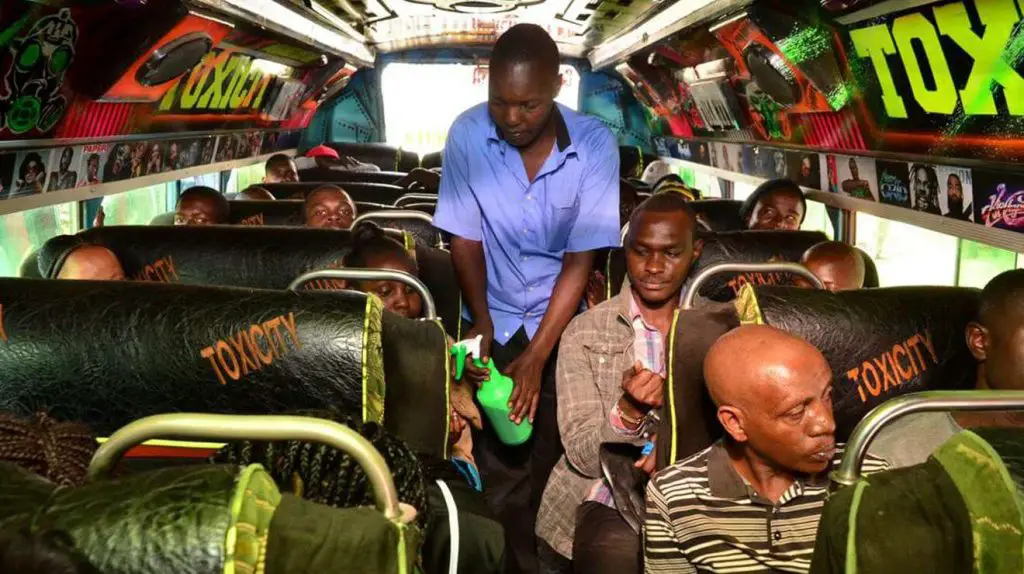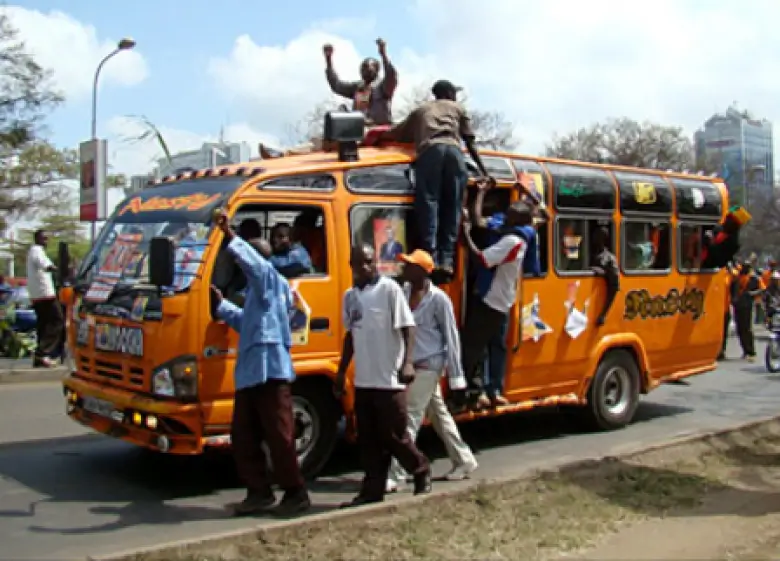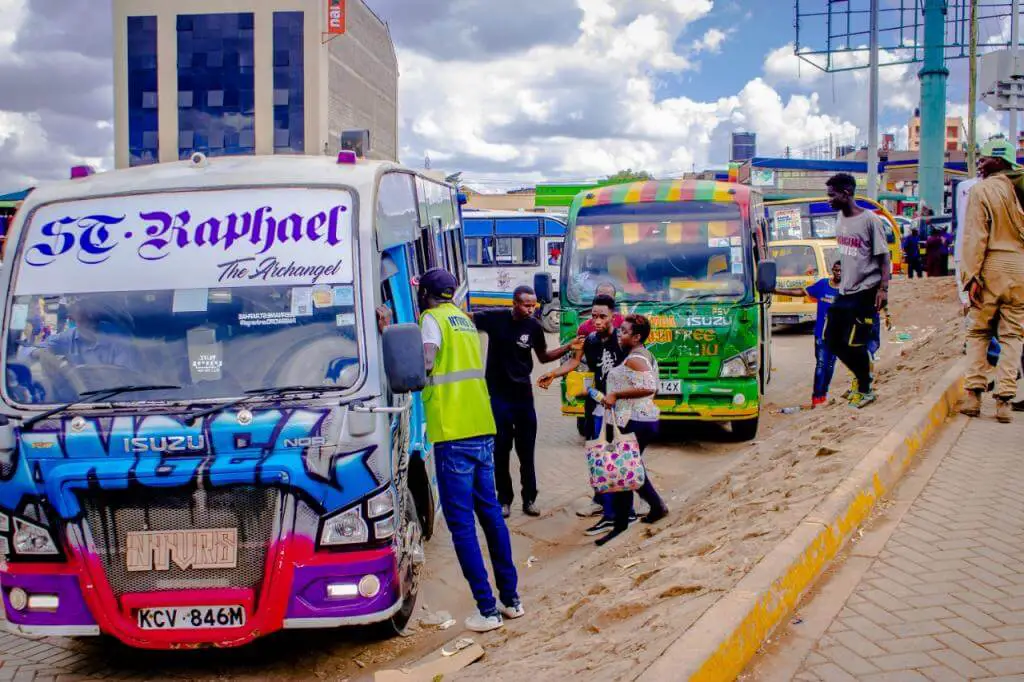Out of all the population of Kenya, only less than 10% own personal cars.
The rest of the population commutes to work using public means, and a few selected with the capabilities use private means such as cabs and Uber.
Also, to save on fuel cost, even personal car owners at times opt to use public means.
Public means in Kenya include matatus (mini-buses) for short commutes, and shuttles and buses for long-distance travel.
Of these, the most commonly used are matatus.
What Are Matatus In Kenya?
Matatus are mini-buses and vans used for public commutes.
The term matatu originated from the Kikuyu word “Mang’otore matatū”, meaning “three 10 cents” that passengers would pay when this mode of transport was first introduced.
Some suggest that the term originates from the Swahili word “matatu” meaning 3 pennies matatus used to charge.
Matatus are privately owned and managed mostly by Saccos, and at times individuals, and can also be referred to as shared taxis.
They are found at central locations, otherwise known as terminuses, where passengers board from, and they only leave once they are full.
All matatus have fixed routes. In between terminuses there are pick-up and drop-off points for passengers.
However, Kenya is not the only country that uses mini-buses and vans.
All developing countries in Africa and the world at large use shared taxis, but they bear different names.
For example, in the neighboring country Tanzania, they are referred to as “dala dala”, in Rwanda “twegerane”, and Nigeria “danfo” for minibuses and “molue” for midibuses.
Matatu Culture in Kenya

Matatus were first introduced in Kenya in the 1960s.
Their popularity grew in the 1980s through to early 2000, when Japanese microvans were introduced, and people would board from the back door and sit facing each other.
During that time, there were no government regulations put in place, and so they were regarded as unsafe, from hijacking to theft, verbal abuse to sexual harassment and abuse.
When John Michuki took over as Minister of Transport and Communications, he set rules that began implementation in February 2004.
Since then, the matatu business grew and people felt safe after matatu crimes dropped by 90% within three months of the ‘Michuki Rules’ enforcement.
New matatu models also saw the business thrive, and the comfort they provided attracted more and more users.
Unlike the old days, most matatus now have music systems put in place. They play the latest music, ‘zilizopendwa’, and broadcast local radio stations.
This has greatly influenced music in Kenya, as it familiarizes people with the latest songs and upcoming artists.
Why Are Matatus Decorated In Kenya?
Matatu owners go to great lengths to decorate their matatus.
They feature celebrities such as movie stars, artists, Disney characters, animations and so much more.
This costs money and time. On average, ‘pimping’ a matatu costs between $2,500 to $5,000 according to most decorating artists. This is work that could take from 3 weeks to a month, or even more.
So, why do they make such an investment in decorating matatus?
Well, this tends to attract more clients. I remember when I was younger, we would wait at the stage or terminus for the newest, most pimped matatu.
We would make sure we’ve monitored the exact times it uses the route and make it coincide with the time we leave for school or college.
Decorating a matatu also makes it easy to single out in busy roads as they are easy to spot.
The decorations also create awareness on certain matters in our community.
Artists mostly pimp these vehicles with current affairs—maybe a new artist emerging, promoting a new local show, or featuring new quotes and sayings in town.
These can be displayed both on the inside and the outside of these matatus.
During special events such as campaign and election seasons, decorations on matatus are used to spread a message of peace and promote a certain candidate.
Other special occasions include during the world cup, where you will see some of the great players and team logos featured on the exterior of the matatus.
How Much Do Matatus Charge?
Matatus have fixed charges, especially for passengers boarding from the terminus.
In Kenya, each route has fixed fare charts posted on the board right behind the driver’s seat. They are mainly categorized into two; peak and off-peak fares.
Peak fares are mainly imposed during rush hours and sometimes at night.
For in-between terminuses pick-ups, some touts/conductors will jump at the highest amount they can possibly think of, especially if they suspect you are new to the area.
There are different modes of payment for public transport across the globe.
Some use credit cards, visas, mobile money, or purchase boarding passes and tickets prior to boarding the bus and present it to the driver upon entry or present it to the tout.
In Kenya, there are three main modes of payment. The most commonly used is cash payment. Conductors always have loose change on them at all times.
There are also mobile payments. People are now paying using Lipa na MPESA and Send Money.
Mobile payments also include USSD technology generated by Safaricom in the wake of COVID-19 to introduce passengers and Saccos to cashless rides.
They last one is the ticket booking. Passengers traveling across counties make physical or phone bookings to Sacco offices, make payments, and receive tickets used as boarding passes.
On the ticket they will include the date and time, starting point, destination, and how much you were charged.
What’s Like to Board a Matatus in Kenya?

If you are looking for convenience rather than comfort, boarding a matatu is your pick.
Ubers and Taxis can be quite expensive, especially if you are traveling quite a distance.
You will find that for a distance charged Ksh 50 by matatus, Uber will charge you 10 times that, up to Ksh 500, while a taxi will be about Ksh 700.
The downsides of boarding a matatu are overcrowding and the fact that there are fixed pick-up and drop-off destinations.
Uber or taxi will provide comfort and pick you up and drop you off at a point of your own choosing, and can even go into remote areas that matatus do not get to.
But if you calculate the cost unless in cases of an emergency, most people do not find it worth it, seeing that transport allowance from the salary can only cover a few days’ worth of Uber rides.
Is Matatu Safe For Foreigners?

Though they do not have a very pleasant history, with the government measures put in place, matatus in Kenya have become quite safe for both the locals and foreigners.
Few things to note though….
Pick pocketers in large cities, especially Nairobi, prey on those using their phones near open windows at the terminus and in traffic.
Many have been victims of phone and purse snatching. And even though some good conductors/touts will chase off these pick pocketers, they are not responsible for any property loss.
Some also sneak into matatus and time for when a passenger is dozing off or distracted to steal from them.
To be safe, any time you board a matatu, cling tightly to your belongings and be careful while using electronics.
The theft cases are not as frequent, but it hurts to be a victim and could be quite traumatizing, especially for foreigners.
What Are The Safety Measures In Place For Passengers Using Matatus?
All matatus have safety belts put in place for every seat. This prevents the passenger from incurring severe injuries in case of an accident. This covers the speed governors as well.
Most matatus have a poster inside for a mobile number to call in case of any complaints about the driver, conductor, or the matatu itself.
Are There Any Specific Etiquettes Or Norms To Be Followed While Using Matatus?
Some etiquettes to be followed by matatu passengers are:
- Always give way to those alighting. Where possible, get off the matatu to allow enough room for other passengers to get off without squeezing.
- Do not eat in a matatu. Hundreds of people board that matatu every day, and you can also avoid littering.
- Stay in your zone. It is not right to spread out your legs or place too much luggage on your lap that it extends to the person sitting next to you.
- Do not talk loud on the phone or sing out loud. If traveling with a friend or colleague, keep your personal discussions to yourself.
- If you sit next to a window, always keep it open to allow fresh air in. Airborne diseases such as flu can easily spread. So if you don’t want to feel the wind, or cold, allow someone else to sit at the window.
Can I Board Matatus From and To Kenyan Airports?

Yes you can. There are buses and matatus that carry people to and from the Airport.
Matatus number 34 are most known for carrying passengers to and from the JKIA.
These matatus operate between 6 am and 9 pm Monday through Friday.
They include KBS and City Hoppa, and can be boarded at Kencom or Ambassador Stage for no more than Ksh 100.
Are Matatus Regulated By The Government In Kenya?
Yes, there are certain regulations set by the government. These include speed governors, boarding capacity, and maintenance of the matatus, all meant to ensure the safety of all passengers.
Though not all the rules are enforced, in most cases, it comes down to individuals implementing them, like boarding a matatu that is already at capacity.
There are also traffic police set at certain points along all the routes in the country. They are there to ensure that matatus are in good condition to be on the road, and that they only carry the maximum capacity set for each matatu in the country.
When matatus do not abide by these regulations, they risk getting fined and in worse cases, having the matatu impounded.

